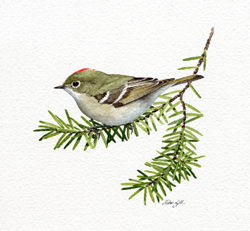Breeding Bird Atlases (BBA)
Find a Bird - BBA1
Breeding Bird Atlas 1 Species Accounts
Ruby-crowned Kinglet
Regulus calendula
Egg Dates
not available
Number of Broods
one

The little but energetic Ruby-crowned Kinglet is a rare breeding species in Massachusetts. It is much better known as a transient, especially in spring when its distinctive song is a prominent feature of songbird migration in late April. The song is remarkable both for its volume and for its lengthy duration and variety of notes. The nineteenth-century ornithologist Eliot Coues, commenting on the voice of the Ruby-crowned Kinglet, said, “If the strength of the human voice were in the same proportion to the size of the larynx, we could converse with ease at a distance of a mile or more” (EHF). Once an observer has heard the song and identifies the songster, the sound is not easily forgotten.
The Ruby-crowned Kinglet is at home in the boreal forest that stretches from Alaska east across Canada to Newfoundland. In New England, it breeds south regularly to central Maine and northern New Hampshire and Vermont. There are historical records of breeding from an area known as Hill 51 in Savoy, Massachusetts. Adults with recently fledged young were reported at this location in July three times from 1915 to 1932. Thus, it should come as no surprise that the only confirmed breeding during the Atlas period came from this same general area and was a report of an adult feeding a fledgling. Whether the Ruby-crowned Kinglet is an erratic, opportunistic breeder in this region or whether a small breeding population is permanently established remains to be determined. A singing male present during June 1977 at Hog Island in Essex was apparently unsuccessful in finding a mate to share his adventure.
During courtship the male sings loudly and exposes his bright crown feathers. The three-part song has been described as eee-tee-tee-tee-too-too-tu-tu-ti-ta-tidaweet-tidaweet-tidaweet. Both sexes have a did-it contact note and a peu-peu alarm call. The pensile nest is a globular affair constructed mainly of mosses. The site is a conifer, most often a spruce, where the nest is placed well out toward the tip of a branch and often at a considerable height of 30 feet or more. The clutch size varies from five to eleven eggs, with seven to nine being typical. Incubation by the female alone lasts about 12 days, and the young remain in the nest for the same period of time. Once the young leave the nest, they are dependent on the adults for about three weeks. There is no data available on nests, eggs, or nestlings in Massachusetts. Adults feeding fledglings in the state have been reported from July 3 to July 19 (ACB). After the nesting season, kinglets may be found associating with warblers, chickadees, and other woodland species.
The first southbound migrants appear in the middle of September. Peak numbers are encountered during the first half of October. Scattered individuals or small groups are found throughout fall into early winter, especially in milder southeastern coastal regions where they can be found in small numbers in mild seasons. The bulk of the population winters in the southern United States, with some individuals going as far as Guatemala.
Map Legend and Data Summary
Atlas 1 data collected from 1975-1979


Note: very rare in coniferous forests at high elevations; one record, but others possible
Richard A. Forster



